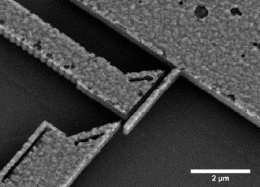September 17, 2010 weblog
Mechanical logic gate: Could levers replace transistors?

(PhysOrg.com) -- Back in the Victorian period, Charles Babbage created a mechanical computer that made use of levers and cogs to get data moving. These days, though, our computers are mostly run using electronic transistors. Nothing too mechanical about those. Unfortunately, when putting together a logic gate for use in computing, the materials used can't withstand some of the heat. Silicon carbide has been used to help fortify regular silicon, which degrades at 250 to 300 degrees Celsius. However, silicon carbide transistors are bulky and slow -- and require high voltages.
In order to get around this problem Te-Hao Lee and a team at Case Western Reserve University turned back to Babbage and his idea of mechanical computing. New Scientist reports on the effort to integrate mechanical computing into our modern electronic systems:
His team has developed a mechanical version of an inverter - the building block used to construct many types of logic gate, which themselves are a fundamental component of digital circuitry within computers. The device uses an arrangement of nanoscale levers instead of transistors. Like a telegraph operator's Morse key, these levers physically make and break contact to pass or block currents.
Application of a voltage makes the levers move under electrostatic attraction. At 550 °C Lee's team managed to get the inverter to switch on and off 500,000 times a second - performing a computation with each cycle.
Such operating temperatures are encouraging. However, there are problems. The mechanical components start to break down after two billion cycles, limiting their usefulness. Additionally, this set up is still slower than the speeds even a normal PC sees. However, the main uses for a mechanical logic gate likely wouldn't be in consumer computing. Instead, such a device would make more sense in situations of very high heat, such as for rocket engines.
More information:
Te-Hao Lee, Swarup Bhunia, Mehran Mehregany, "Electromechanical Computing at 500°C with Silicon Carbide," Science (September 2010). Available online: www.sciencemag.org/cgi/content … stract/329/5997/1316
Paul Marks, "Steampunk chip takes the heat," New Scientist (September 10, 2010). Available online: www.newscientist.com/article/d … -takes-the-heat.html
Hamish Johnston, Logic circuit takes the heat," Physicsworld (September 14, 2010). Available online: physicsworld.com/cws/article/news/43734.
© 2010 PhysOrg.com





















